In an interview conducted by Dr. Damon Adams, Dentistry Today’s editor-in-chief, Dr. Richard Mounce shares his knowledge, advice, and opinions on a variety of endodontic topics. Dr. Mounce is a wet-gloved endodontist who practices in Vancouver, Wash. He lectures globally and is extensively published.
On a personal note of interest, Dr. Mounce is an avid scuba diver and has authored a nonfiction book, Dead Stuck, “one man’s stories of adventure, parenting, and marriage told without heaping platitudes of political correctness,” published by Pacific Sky Publishing, 2009, deadstuck.com.
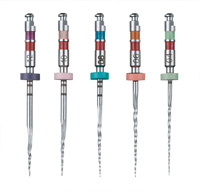 |
| .12/25, .10/25, .08/25, .06/25, and .04/25 Twisted Files (TF). |
 |
|
.08/25 TF, capable of creating a .08 master apical taper routinely in approximately 3 to 4 insertions when a glide path is present. |
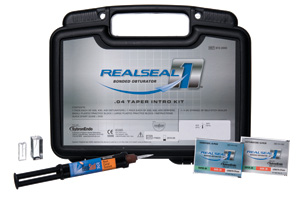 |
| RealSeal bonded obturation master cones. |
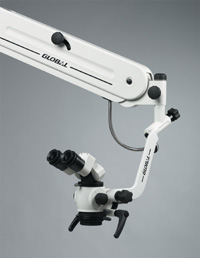 |
|
The surgical operating microscope (Global Surgical). |
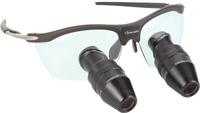 |
| 4.8x Class IV HiRes loupes (Orascoptic). |
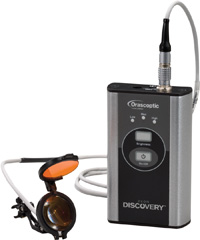 |
| Zeon Discovery Portable LED (Orascoptic). |
Dr. Adams: Implants seem to be on the rise in popularity. Does this affect the future of endodontics, and if so, how?
Dr. Mounce: The future of endodontics is in our own hands much more than any perceived or real threat from implants.
There is rarely an instance where endodontic treatment versus implants are an equal and opposite choice. Evaluating a clinical situation comprehensively and removing the financial interest of the clinician virtually always provides one superior choice. If given a choice, people want to save their natural teeth. The convenience, cost and comfort of a root canal procedure will almost always make endodontics the first and best choice, assuming that the tooth is restorable. Even if the risk benefit equation in treatment planning was evenly matched between endodontics versus implants, the patient should be given realistic success and failure percentages in a completely candid PARQ. Well-informed patients will make the best choice given their situations. Patients who are given an informed choice come back enthusiastically to the clinician who tells them the truth and respects them; not the one that sold them on treatment that may not have been in their best interest.
Unfortunately, though, despite the above, I am aware of oral surgeons and periodontists making specious assertions to encourage patients to extract teeth without even giving them the option of tooth retention. Telling patients that root canal treatment fractures teeth, or extracting nonvital teeth with lesions, again without giving the patients the option of endodontics is self-serving in the extreme. It is not how I would wish to be treated. I have had 3 implants and 3 root canals; given the choice of having a root canal or implant, I know which I would prefer.
The above notwithstanding, implants are a blessing in disguise to endodontics. In my view, implants are challenging endodontics at every level to be all that the procedure can and should be. Much like “guns don’t kill people, people kill people,” bad root canal treatment leads to unsuccessful results, and good treatment to clinical success. While the analogy is not perfect (guns left alone don’t kill people), it is neither the fault of the guns nor the root canal treatment if either is misapplied and leads to a catastrophe.
To address these challenges—whether it be in dental schools, manufacturers’ product offerings and technique recommendations, endodontic continuing education (CE), the research done in the specialty and published in the Journal of Endodontics and the International Endodontic Journal—clinically relevant literature based methods of optimal treatment should be advanced as ubiquitously as possible for clinicians across the world. I realize that this is massive task, but it calls for leadership from the American Academy of Endodontics (AAE) to publically continue to answer the specious claims of clinicians who make such unfounded assertions.
Dr. Adams: Should endodontists be placing implants?
Dr. Mounce: Absolutely, as along as the endodontist is properly trained, has the right equipment, and is using sound clinical principles. All things being equal, apical surgery under the surgical operating microscope (SOM) is far more complex than implant placement. If endodontists can do apical surgery at the level they do routinely, they can certainly place implants at a very high level.
Dr. Adams: In your opinion, what does the future for endodontic surgery look like?
Dr. Mounce: The indications for endodontic surgery have diminished with the advent of the SOM (Global Surgical) and greater adaptation of aids such as the higher-powered loupes (Orascoptic) with light sources. Many cases that previously needed endodontic surgery are now predictably retreated. My favored subspecialty within endodontics is retreatment of previous failures. This is ironic because I did a large number of surgeries in my residency at Oregon Health Sciences University. In 1991, when I graduated from my endodontic residency, there was little if any emphasis on visualization and magnification. Through the SOM, the tooth comes alive, especially in retreatment and canal location in first-time orthograde treatment. For example, virtually every crown that I access for retreatment shows overt evidence of coronal microleakage under the SOM. Once identified, correcting the source of the endodontic failure is predictable (missed canals, coronal microleakage, iatrogenic events). Once accessed, using enhanced visualization and magnification, identifying those cases that need extraction is relatively simple. In essence, with the visual acuity provided by the SOM, the number of cases that require endodontic surgery (with and without retreatment first) has become smaller. That said, when necessary, if carried out appropriately on restorable teeth that are not vertically fractured, surgical success rates exceed 90%. Endodontic surgery will remain a viable option for natural tooth retention into the long-term.
Dr. Adams: Should general dentists be doing endodontic retreatment and surgery?
Dr. Mounce: An excellent and very loaded political question! The short answer is emphatically “No,” unless they are highly trained in a university or mini-residency setting with live patients under specialist supervision using the SOM and have formally studied the relevant literature. Even under these circumstances, there are a select group of cases that should virtually always be referred.
Both retreatment and apical surgery are highly detailed, technique-sensitive procedures with a far smaller margin of error relative to orthograde first-time root canal treatment. For example, trying to remove a separated rotary nickel titanium (Ni-Ti) file fragment from the middle or apical third of a lower second molar mesial root is technically the dental equivalent of climbing a Himalayan mountain. It can be done, but it is not the place for the novice, especially when there are better referral options. Empirically, it is my experience, having given several hundred CE courses over the past 7 years across the globe, that the old expression holds true. There is what you know, what you don’t know, and what you don’t know that you don’t know. Unless a clinician has spent a great deal of time honing his or her skills in everything from tissue management to the use of ultrasonics, it is difficult to envision that the final surgical result will be comparable to the experienced endodontist. Also, a simpler way to determine whether any given clinician is the correct one to perform surgery or retreatment is to ask a simple question, “If this patient were someone I loved, am I the best person to treat him or her?”
Dr. Adams: What are the hottest topics in endodontics today?
Dr. Mounce: At this time, there is a fierce struggle for supremacy of the Ni-Ti market. Sybron and DENTSPLY as the titans in this fight are ferociously slugging this battle out across the world. By virtue of their competition, evolving improvements in Ni-Ti materials and design will remain at the forefront of the specialty. When DENTSPLY’s patents on grinding of Ni-Ti expire in the coming years, North America will be flooded with an alphabet soup of different rotary Ni-Ti (RNT) options. Along these lines, I have my preferences (detailed below), but that said, the use of heat treatments in RNT manufacture and their effect on the functional characteristics of RNT instruments is simply spectacular. RNT files are more flexible, cut more efficiently and fracture less than ever before. In addition, a great deal of research has been done on RNT files, and as a result, we now know much more than we did before about how these files operate at a micro and macro level. As much as I like the Twisted File (TF) (SybronEndo), any rotary Ni-Ti file can be used to provide excellent results, and do so efficiently and safely, if it is used correctly. This said, RNT files are quite different in their cutting ability, fracture resistance and flexibility. RNT files are not a one-size-fits-all commodity.
Secondarily, adhesion has come to the root canal space. I have bonded all of my obturation with RealSeal (SybronEndo) since January 2004. It is now possible with bonded obturation to provide a biocompatible obturation that reduces microleakage across the totality of the canal from the orifice to the apex relative to gutta-percha. While gutta-percha has its proponents and champions, it is going the way of the dinosaur. I believe to argue for gutta-percha is cognitive dissonance of the highest order. It is only a matter of time before we are all bonding in the root canal system. In vitro and in vivo, there is overwhelming evidence that a bond is created in the canal relative to gutta-percha and the functional significance of this cannot be overstated, given the absolute correlation in the endodontic literature between coronal leakage and clinical failure. I grant that the bond in root canal systems is not a particularly strong one, that a monoblock is not predictably created, and that the obturation does not definitively strengthen roots—that said, when my wife needed a retreatment of a failed gutta-percha Thermafil root canal, I used RealSeal.
Third, the area of optimal irrigation efficacy has emerged as a growing niche of interest. Numerous products have joined the clinical marketplace in the past several years: negative pressure irrigation, sonic activation, ultrasonic activation, photo activated disinfection (in Europe), laser energy, and mechanical agitation of irrigation solutions. While at this time, none of these methods have shown an absolute superiority over another, it is essential for clinicians to be activating their irrigation with one method or another. I favor ultrasonic activation, as it is simple and efficient in my hands, relative to the alternatives. This is an emerging area that has not seen a final proof of superiority. My suspicion is that in the long term, we will have methods that are shown via the endodontic literature to definitively provide the cleanest possible, if not sterile, canal.
Fourth, cone beam technology will revolutionize endodontics much like the SOM did. A clinician can never have too much information from which to treatment plan. The capabilities of cone beam technology to help the clinician to identify risk factors, iatrogenic events, and nonrestorable teeth can only improve endodontic success and advance the specialty.
Dr. Adams: What is the single thing that general dentists could do to make endodontic treatment more painless, predictable, and profitable?
Dr. Mounce: The answer is deceptively simple, but I need to mention 2 things. First, get a surgical operating microscope. The SOM has been a quantum leap for endodontics and dentistry. Second, learn to use hand K files. With so many Ni-Ti file systems and manufacturer claims of superiority, there is marketplace confusion, and clinicians are often skipping steps, believing that one system or another can solve curvature and calcification challenges and do so without an appreciation of the clinical challenges present. As a result, some clinicians are rushing into canals without achieving patency and/or properly creating the necessary glide path to minimize canal transportation and file fracture.
All of the Ni-Ti systems function more efficiently if the clinician has done the required manual preflaring and negotiated the canal correctly with hand K files. Clinically, this means that before Ni-Ti files of any type are placed into a canal, the canal should have the initial diameter of a No. 15 hand K file. Often in a calcified and constricted canal, the No. 6 hand K file must first be precurved and inserted to the apex. In addition, it may be necessary to trim the hand K file to make it the correct length to achieve full tactile control. Trimming a hand file also customizes its tip size and makes it slightly more rigid. This rigidity allows an intentional pressure to be placed on the file tip that is valuable in breaking through a blockage or to bypass a ledge. Appreciating and observing the curvature that results on hand K files after their insertion into complex roots can go far toward minimizing subsequent Ni-Ti fracture, because the clinician can appreciate the complexity of the root anatomy that will be prepared subsequently with Ni-Ti files.
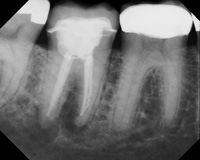 |
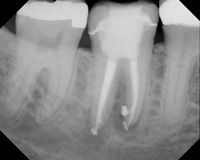 |
|
Clinical case of a failed root canal retreated with TFs and RealSeal bonded obturation via the SystemB technique. |
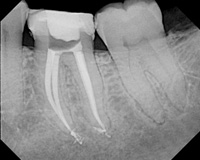 |
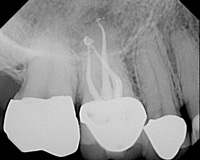 |
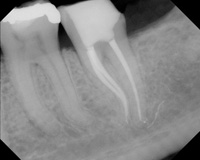 |
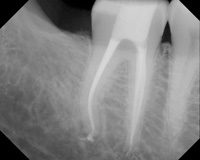 |
| Clinical cases treated with TFs and RealSeal bonded obturation master cones via SystemB technique. |
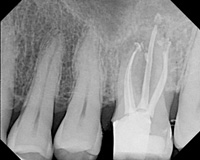 |
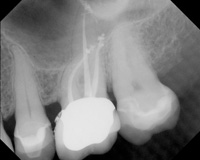 |
| Clinical cases treated with TFs and RealSeal One Bonded Obturators. |
Dr. Adams: You mentioned several new technologies. What systems are you currently using and why?
Dr. Mounce: I am on the advisory board of SybronEndo and I receive honorarihonorarium for some aspects of that work, such as lecturing. That said, I teach the way I practice and I can use and afford any products I wish without restriction. I buy my files and materials from SybronEndo. With that background, I use the M4 Safety handpiece, the TF and RealSeal in the form of both master cones and RealSeal One Bonded Obturators. Given the capabilities of the TF to create a .08/25 preparation (before enlargement of the master apical diameter) in 3 to 4 insertions is nothing short of spectacular. Being able to take a .08 taper around a 90º curvature with the TF and prepare such larger tapers to the apex is similarly impressive.
As mentioned above, in vitro and in vivo, there is abundant evidence in the endodontic literature that bonding the obturation with RealSeal provides a better seal and resistance to coronal leakage relative to gutta-percha across the totality of the canal space. Having used bonded obturation exclusively since January 2004, I would never go back to using gutta-percha. In addition, one of the cool features of bonded obturation is that the clinician has the choice of using RealSeal master cones and/or RealSeal One Bonded Obturators, ie, a carrier-based form of bonded obturation product that can be easily adopted by clinicians who are now using warm carrier-based gutta-percha systems.
Dr. Adams: Are there in fact 2 standards of endodontic care: one for the general dentist, and one for the specialist?
Dr. Mounce: I have lectured extensively across the globe in the past 7 years. From Riyadh to Rapid City, St. Petersburg to Singapore, Buenos Aires to Boston, clinicians all over the world have the same questions. Given the economics, differences in dogma and equipment, while the global standard should be one, it is not. While I think there should be one standard, there never will be. This said, I do not and will never believe that there is an excuse for a lack of early referral. So much of endodontic success and failure is determined before the handpiece is ever picked up. Case assessment and treatment planning are essential to determine restorability and the risk factors of any given anticipated treatment. It is absolutely essential to determine if the particular case is within the skill level of the clinician given his or her time, level of skill and equipment. If there is any compromise with regard to the treatment that can be rendered, unless there is no other option, the patient should be referred.
The legal and ethical standard has been that the treatment performed by general dentists should be of the same standard as that of the specialist. While that is the goal at the level of the ivory tower or the courtroom and many general dentists perform stellar root canal treatment, this is not the case across the entire spectrum of clinicians. It is not challenging to see where this disparity arises. Some clinicians are using Gates Glidden drills, stainless steel hand files and naked eye visualization. Others are using instruments like the TF and RealSeal bonded obturation under the SOM with digital radiography and even cone beam technology. While the principles that guide endodontic treatment do not change, and it is possible to achieve excellent results with Gates drills and stainless steel hand files, this antiquated method is far more technique sensitive and open to clinician error relative to using the best technology available with experienced hands.
Dr. Adams: The number of new endodontic systems seems to be increasing exponentially every day. As new technologies and materials are introduced, is this causing confusion?
Dr. Mounce: Absolutely, more than you might imagine. It is possible using virtually any of the present systems to achieve an excellent 3-dimensional result, the challenge is to decide which of the systems is the most user friendly, efficient, and easy to learn.
While endodontics should be principle driven, there are a large number of clinical concepts and principles that are not agreed upon amongst clinicians across the world.
It is not hard to see where the confusion arises. For example, is the ideal termination point of cleansing, shaping and obturation the minor constriction of the apical foramen, or is it several millimeters back; and does it make a difference where the termination point should be if the case is vital necrotic? Is single-cone root canal filling a good idea? What is the ideal master apical diameter? I could go on indefinitely with such questions, but just these topics alone cause significant debate among specialists, much less general dentists. Schools in the same cities teach different methods and materials, and even specific technique recommendations. So the challenge in my mind is not how to chose the particular means to achieve the principles but rather how to achieve a global consensus as to what a root canal actually is and what principles guide this endeavor.
Dr. Adams: With so many endodontic companies and products available, how do you decide which products to use?
Dr. Mounce: This is a very tough question to answer for all clinicians, general dentists and endodontists alike. I believe the simplest way is to practice on extracted teeth and see what feels the best in the clinician’s hands and what produces the optimal result. I certainly would not base what I use on the advice of an opinion leader, which must be a strange statement coming from me. I do not consider myself an opinion leader. There is far too much opinion, bias and mythology in our specialty. I teach in the same manner I practice. I am in full-time practice, so unlike some presenters, I am wet-gloved. In my opinion, it is disingenuous for a lecturer to teach, if he/she neither uses the products on live patients nor has any real semblance of experience from which to understand the functional capability of the instruments they are teaching. I’ve had a chance to use all the systems available in North America and I’ve chosen RealSeal and the TF mentioned above because I use them every day. They work efficiently and in the manner that I teach them.
To learn more at every level of the specialty, I would encourage general practitioners to read everything they can get their hands on about endodontics. In addition, take every endodontic CE class possible and consider going to the AAE meeting, and/or biennial the European Society of Endodontics meeting, for the latest in research and clinical tips. There are a number of fine clinical magazines, including Endodontic Practice USA, Endo Tribune, and Oral Health, among others that can guide clinicians. Also, the Journal of Endodontics and the International Endodontic Journal bring a wealth of clinical and scientific information into the operatory from the best clinicians and researchers in the world.
Dr. Mounce can be reached via e-mail at lineker@comcast.net or at deadstuck.com.
Disclosure: Dr. Mounce is on the advisory board of SybronEndo and receives honorarium for some aspects of that work.







